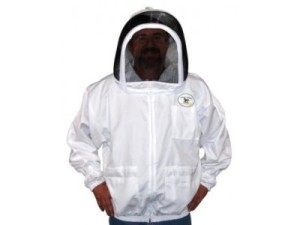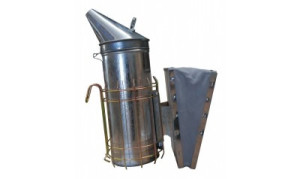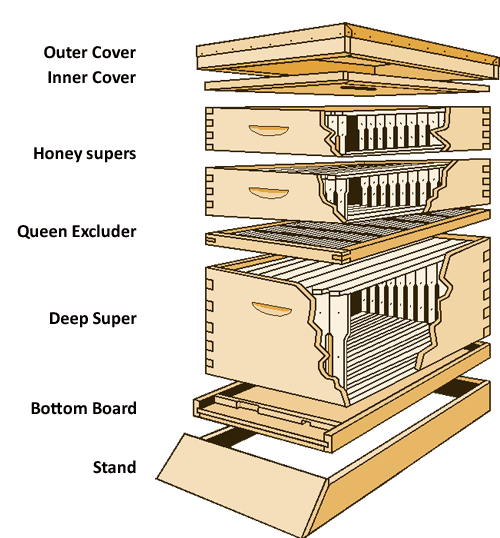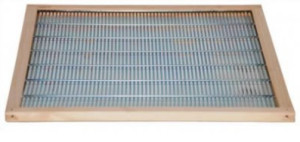Welcome to NewBee University!
Lesson 2: Buying Beekeeping Equipment
Introduction
Newbees often struggle with knowing what beekeeping equipment is needed to get started. Some opt for the prepackaged “starter kits” which will get you started but may also cost you more than knowing what you are looking for. Becoming familiar with the names of beekeeping equipment, especially the parts of the hive, will go a long way toward helping you understanding beekeeping lingo and better prepare you for talking bees with fellow beekeepers. This lesson will describe the beekeeping equipment including: protective gear, hive parts, and honey harvesting. This lesson will also describe what is needed by a NewBee the first year and what can wait.
1.) Protective Gear
Once you become a beekeeper your respect for honey bees will increase greatly and your fear of them will decrease just as greatly. This does not mean that you should not have a healthy respect for the fact that you are working with a living creature and you can not always predict their behavior, especially as a NewBee. Bees can be docile one day and our for revenge the next. Proper protective gear will ensure you are prepared to take good care of your bees on good days and bad.

Bee Suit
A bee suit can be full body or just a jacket. Bee suits are specially made to protect you from bee stings. A long sleeve shirt is not a adequate substitute. Bee suits have heavy elastic around the wrists, waist, and if a full suit the ankle to prevent bees from getting in. Many suits have attached veils that zip on and off making then very “bee tight.” When buying a bee suit it is very important to be sure you know if it does or does not include the veil. You may think you found a great price on a suit just to discover it does not include a veil. I have found that the jacket style bee suit along with an old pair of khakis works great for me. I feel like the whole body suit would have been overkill for me and very hot. I do have to remind myself on hot days to change out of my shorts and into long pants before heading into the bee yard.
Veil
The veil is one of the most important pieces of protective gear. Bees seem to instinctively target the face and I have been told by many veteran beekeepers that no matter how comfortable they are with their bees they always wear their veil (even if they are wearing shorts and a t-shirt). I have found that my veil that attaches to my bee jacket works great and protects me very well.

Here is a highly reviewed bee suit at a great price: Beekeeping Jacket with Fencing Veil
2.) Beekeeping Tools
Smoker
Your smoker is a very important tool in keeping your bees calm and easier to work. More important than the type of smoker you buy is learning how to use it properly, which we will cover in a later lesson. A smoker is an essential tool for every Newbee (and veteran alike). Here’s a good one: Stainless Steel Smoker
Hive Tool
Hive tools are used to separate hive bodies and frames that have been stuck together by the bees with Propolis (bee glue), scraping extra comb built up in the incorrect place (burr comb) and any other job a beekeeper might come across in the bee yard. While these may just look like little pry bars they are one of your most handy tools and worth the investment to get a nice one. I would strongly recommend getting one with a “J” end as it is great for pulling up the ends of frames.
Here is the hive tool I use and like: J Hook Hive Tool
3.) The Hive
Obviously a hive is a necessity when keeping bees. When looking for a hive to buy it is important to remember that the first year you have bees they are going to be working very hard to draw out the comb that they need in their hive and they will most likely not produce extra honey the first year. With that being said you would not want to find yourself in the middle of the best year ever with bees ready to make extra honey and not have the equipment to allow them to store up that honey. For this reason we would recommend buying a hive with two deep hive bodies and one or two medium supers. While you would be very very lucky to need one let alone two honey supers your first year you would be worse off if you needed them and did not have them.
Bee Hive Parts
Outer Cover / Telescoping Cover
The outer cover is the “roof” of your hive. It is sometimes called a telescoping cover describing how it hangs over the edges of the hive slightly. It protects your hive from the elements. Outer covers are often made of wood covered with aluminum sheeting on the top to both make it water proof and reflect the sins heat. Sometimes outer covers are made of a heavy white plastic.
Inner Cover
As you might guess this cover goes inside the outer cover. It sits on top of your hive bodies or supers and helps increase ventilation and also makes sure the bees do not propolize (glue) the outer cover to your hive. It is important that this piece be placed with the rim faced up and the flat surface down. Most are stamped with the words “This side up” but it is worth mentioning as NewBees like to place these upside down and the bees like to return the favor with a mess of wax in the wrong place.
Honey Supers
Honey supers are the boxes where you will eventually be collecting your bees surplus honey for harvesting. They are called supers because they go above the hive bodies. Honey supers could be deeps (9 1/2 inches deep), mediums (6 5/8 inches deep), or shallows (5 11/16 inches deep), but are most commonly mediums. Deeps can store more honey, but as a result can be over 90 pounds each when full, more than most can lift in the awkward position you have to bee in to pull a super off of a tall hive. On the other hand shallows do not hold as much honey, but this is preferable to beekeepers that are older or who have bad backs.

Hive Bodies
Hive bodies are the lower boxes of the hive and are where they brood are raised, sometimes referred to collectively as the brood chamber. Most commonly two deeps are used for the brood chamber. It is also worth mentioning that hive bodies can come in the traditional 10 frame or narrower 8 frame size. This is beekeeper preference but it is important to know which you are getting and then to get both your hive bodies and honey supers the same size.
Frames
Frames are the individual and removable pieces of woodware that the bees build their honey comb on. There are several different styles that vary based on the type of foundation you use. The supplier you are buying from will be helpful in ensuring you get the right frame for your foundation. You will also need to make sure you get the right depth frame. Frames go by the same terminology as hive bodies and supers they fit; deep, medium, or shallow.
Foundation
Foundation is the base that is placed inside the frame that gives the bees their start. Foundation can be wax, wax with wires, or plastic coated with wax. If you are looking to go a bit more natural you will want bees wax foundation and getting it with wires is best for added support. If you are looking more for durability and long lasting foundation plastic is a great choice. It is important to get plastic that has been coated in bees wax to ensure your bees will build on it. Most frame designs require foundation to be held in place with pins that are placed through pre-drilled holes in the sides.
Bottom Board
The bottom board is the base on which the hive sits and provides the entrance and landing board for the bees to enter on. It is best to get a screened bottom board which allows for increased ventilation and is thought to help control the Verroa Mite (a bee parisite).
4.) Beekeeping Equipment Not Needed the First Year
 Queen Excluder
Queen Excluder
A queen excluder is a plastic or metal grate (metal ones look like BBQ grill grates) that are used to keep the queen in the hive body and out of the honey super. They are simply placed on top of the hive bodies and then the honey supers go above. The queen is much larger and can not fit while workers are small enough to go right through. These are not REQUIRED the first year because the odds are good you will not be making much honey the first year. Throughout your first year you will also collect 1,001 opinions on the use or non-use of queen excluders from other beekeepers, most of which prefer whatever it is they are currently doing, of course.
Honey Extractor
While many NewBees look forward to this part of beekeeping it is not likely you will be extracting honey your first year. If you do find yourself lucky enough to have some honey to extract your first year it would be best to find a fellow beekeeper who is willing to let you join them when they extract their honey and run your frames through the extractor as well. Some beekeepers associations also rent our extractors. Extractors are big expense and it would be a shame to buy one a year before you need it and then in that year learn that you wish you had bought a different style or brand. When it comes to extractors it is best to wait.
5.) Buying Assembled Vs Unassembled Hives
Bee hives, specifically the hive bodies, supers, and frames, can be purchased assembled or unassembled for a slightly reduced price. The time you will spend assembling your first hive or hives will out weigh the money you save. The advantage with buying unassembled hive parts is that you will likely have a stronger longer lasting hive, as manufacturer assembled hives are often not glued, but only nailed. With that said, because of the time it will take you to assemble your hive, you should only buy unassembled hive parts if you think that you will enjoy the building process and have the time to commit to assembling them.
6.) Buying Used Beekeeping Equipment
It is not recommended that NewBees buy used hives or hive parts. Many of these parts are not being used by their owner because they were from a “dead out” (a colony that died out). While the colonies that used to call these hives home may have simply died from starvation it could also be from something much more serious like disease or pests. Some of the diseases and causes of death can linger and inflict future colonies raised in these hives. After a few years of beekeeping your experiences and learning will have expanded so greatly they you will better be able to assess the use of used beekeeping equipment, but as a NewBee it is best to avoid it.


